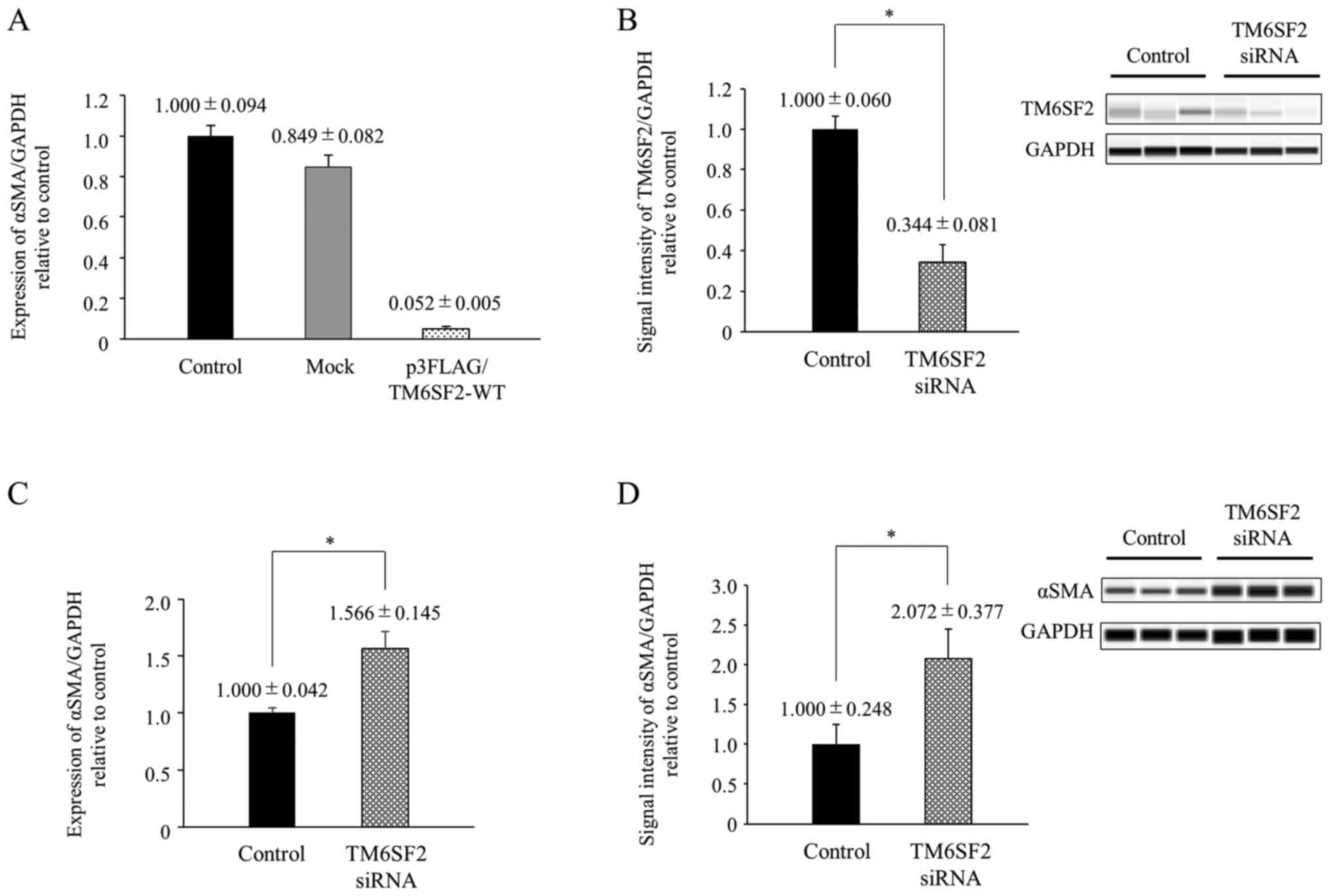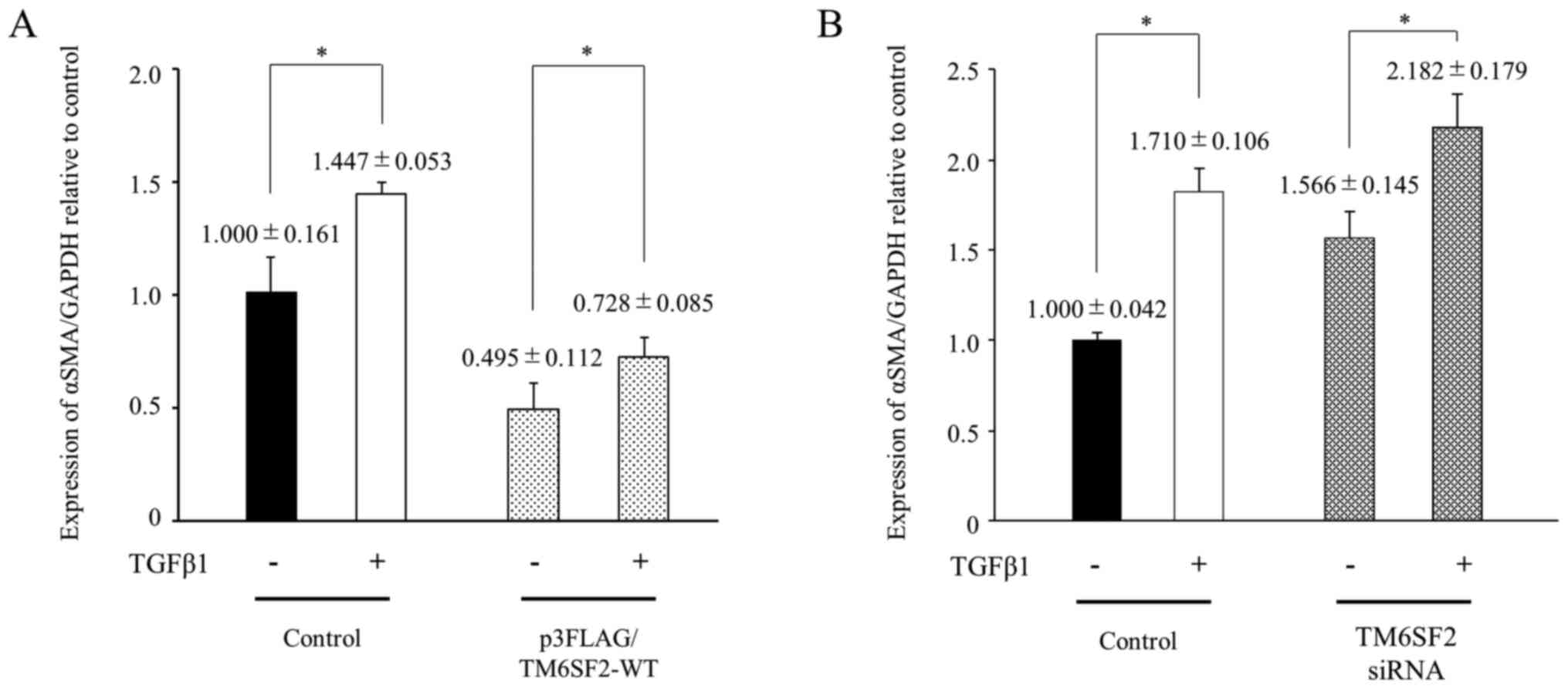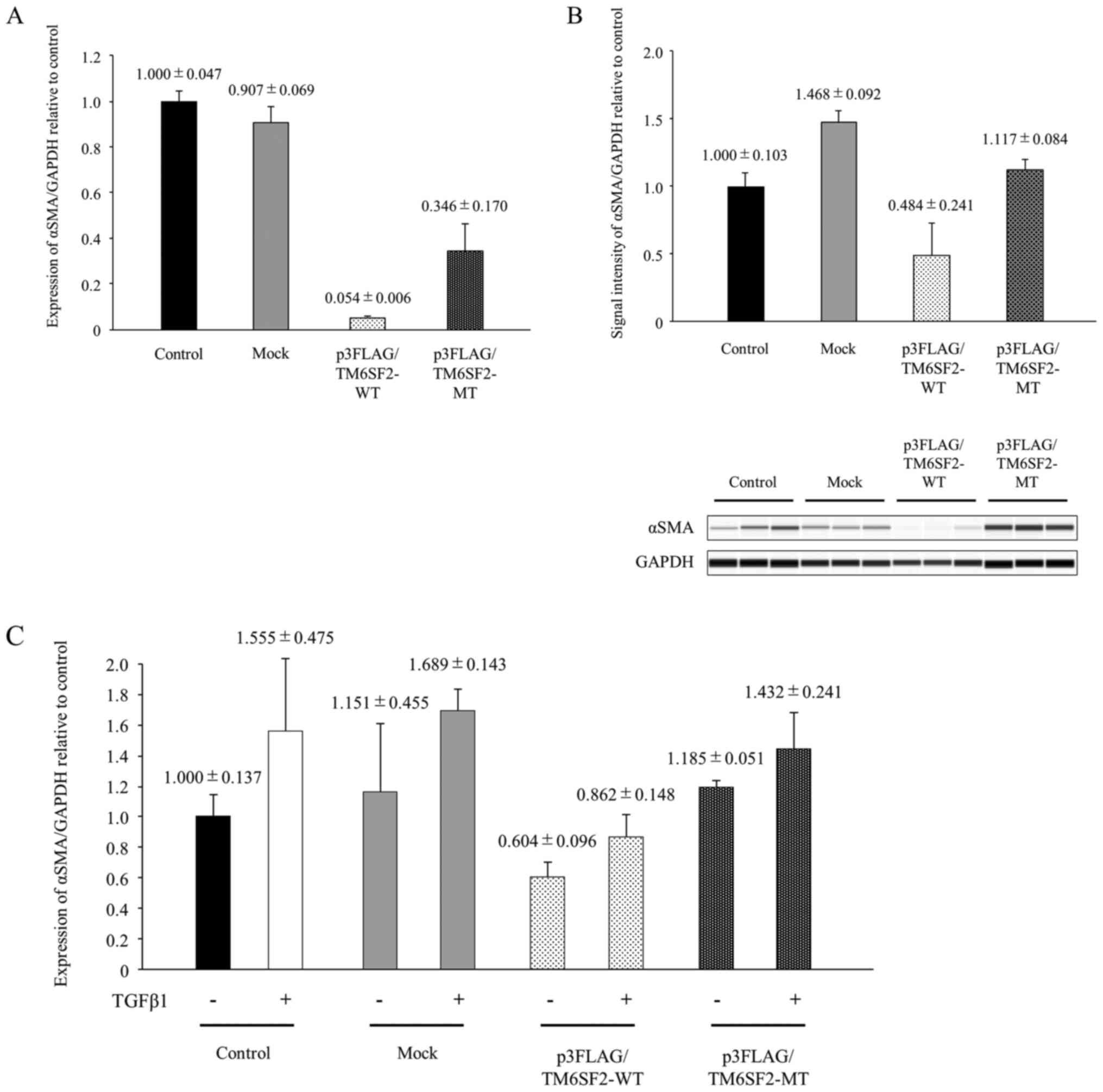|
1
|
Eslam M, Valenti L and Romeo S: Genetics
and epigenetics of NAFLD and NASH: Clinical impact. J Hepatol.
68:268–279. 2018. View Article : Google Scholar : PubMed/NCBI
|
|
2
|
Kleiner DE, Brunt EM, Van Natta M, Behling
C, Contos MJ, Cummings OW, Ferrell LD, Liu YC, Torbenson MS,
Unalp-Arida A, et al: Design and validation of a histological
scoring system for nonalcoholic fatty liver disease. Hepatology.
41:1313–1321. 2005. View Article : Google Scholar : PubMed/NCBI
|
|
3
|
Angulo P, Kleiner DE, Dam-Larsen S, Adams
LA, Bjornsson ES, Charatcharoenwitthaya P, Mills PR, Keach JC,
Lafferty HD, Stahler A, et al: Liver fibrosis, but no other
histologic features, is associated with long-term outcomes of
patients with nonalcoholic fatty liver disease. Gastroenterology.
149:389–397. 2015. View Article : Google Scholar : PubMed/NCBI
|
|
4
|
Romeo S, Kozlitina J, Xing C, Pertsemlidis
A, Cox D, Pennacchio LA, Boerwinkle E, Cohen JC and Hobbs HH:
Genetic variation in PNPLA3 confers susceptibility to nonalcoholic
fatty liver disease. Nat Genet. 40:1461–1465. 2008. View Article : Google Scholar : PubMed/NCBI
|
|
5
|
Speliotes EK, Yerges-Armstrong LM, Wu J,
Hernaez R, Kim LJ, Palmer CD, Gudnason V, Eiriksdottir G, Garcia
ME, Launer LJ, et al: Genome-wide association analysis identifies
variants associated with nonalcoholic fatty liver disease that have
distinct effects on metabolic traits. PLoS Genet. 7:e10013242011.
View Article : Google Scholar : PubMed/NCBI
|
|
6
|
Singal AG, Manjunath H, Yopp AC, Beg MS,
Marrero JA, Gopal P and Waljee AK: The effect of PNPLA3 on fibrosis
progression and development of hepatocellular carcinoma: A
meta-analysis. Am J Gastroenterol. 109:325–334. 2014. View Article : Google Scholar : PubMed/NCBI
|
|
7
|
Hotta K, Yoneda M, Hyogo H, Ochi H,
Mizusawa S, Ueno T, Chayama K, Nakajima A, Nakao K and Sekine A:
Association of the rs738409 polymorphism in PNPLA3 with liver
damage and the development of nonalcoholic fatty liver disease. BMC
Med Genet. 11:1722010. View Article : Google Scholar : PubMed/NCBI
|
|
8
|
Sookoian S, Castaño GO, Scian R, Mallardi
P, Fernández Gianotti T, Burgueño AL, San Martino J and Pirola CJ:
Genetic variation in transmembrane 6 superfamily member 2 and the
risk of nonalcoholic fatty liver disease and histological disease
severity. Hepatology. 61:515–525. 2015. View Article : Google Scholar : PubMed/NCBI
|
|
9
|
Pirola CJ and Sookoian SL: The dual and
opposite role of the TM6SF2-rs58542926 variant in protecting
against cardiovascular disease and conferring risk for nonalcoholic
fatty liver: A meta-analysis. Hepatology. 62:1742–1756. 2015.
View Article : Google Scholar : PubMed/NCBI
|
|
10
|
Macaluso FS, Maida M and Petta S: Genetic
background in nonalcoholic fatty liver disease: A comprehensive
review. World J Gastroenterol. 21:11088–11111. 2015. View Article : Google Scholar : PubMed/NCBI
|
|
11
|
Goffredo M, Caprio S, Feldstein AE,
D'Adamo E, Shaw MM, Pierpont B, Savoye M, Zhao H, Bale AE and
Santoro N: Role of TM6SF2 rs58542926 in the pathogenesis of
nonalcoholic pediatric fatty liver disease: A multiethnic study.
Hepatology. 63:117–125. 2016. View Article : Google Scholar : PubMed/NCBI
|
|
12
|
Liu YL, Reeves HL, Burt AD, Tiniakos D,
McPherson S, Leathart JB, Allison ME, Alexander GJ, Piguet AC, Anty
R, et al: TM6SF2 rs58542926 influences hepatic fibrosis progression
in patients with Non-alcoholic fatty liver disease. Nat Commun.
5:43092014. View Article : Google Scholar : PubMed/NCBI
|
|
13
|
Dongiovanni P, Petta S, Maglio C,
Fracanzani AL, Pipitone R, Mozzi E, Motta BM, Kaminska D, Rametta
R, Grimaudo S, et al: Transmembrane 6 superfamily member 2 gene
variant disentangles nonalcoholic steatohepatitis from
cardiovascular disease. Hepatology. 61:506–514. 2015. View Article : Google Scholar : PubMed/NCBI
|
|
14
|
Li TT, Li TH, Peng J, He B, Liu LS, Wei
DH, Jiang ZS, Zheng XL and Tang ZH: TM6SF2: A novel target for
plasma lipid regulation. Atherosclerosis. 268:170–176. 2018.
View Article : Google Scholar : PubMed/NCBI
|
|
15
|
O'Hare EA, Yang R, Yerges-Armstrong LM,
Sreenivasan U, McFarland R, Leitch CC, Wilson MH, Narina S, Gorden
A, Ryan KA, et al: TM6SF2 rs58542926 impacts lipid processing in
liver and small intestine. Hepatology. 65:1526–1542. 2017.
View Article : Google Scholar : PubMed/NCBI
|
|
16
|
Luukkonen PK, Zhou Y, Nidhina Haridas PA,
Dwivedi OP, Hyötyläinen T, Ali A, Juuti A, Leivonen M, Tukiainen T,
Ahonen L, et al: Impaired hepatic lipid synthesis from
polyunsaturated fatty acids in TM6SF2 E167K variant carriers with
NAFLD. J Hepatol. 67:128–136. 2017. View Article : Google Scholar : PubMed/NCBI
|
|
17
|
Prill S, Caddeo A, Baselli G, Jamialahmadi
O, Dongiovanni P, Rametta R, Kanebratt KP, Pujia A, Pingitore P,
Mancina RM, et al: The TM6SF2 E167K genetic variant induces lipid
biosynthesis and reduces apolipoprotein B secretion in human
hepatic 3D spheroids. Sci Rep. 9:115852019. View Article : Google Scholar : PubMed/NCBI
|
|
18
|
Mahdessian H, Taxiarchis A, Popov S,
Silveira A, Franco-Cereceda A, Hamsten A, Eriksson P and van't
Hooft F: TM6SF2 is a regulator of liver fat metabolism influencing
triglyceride secretion and hepatic lipid droplet content. Proc Natl
Acad Sci USA. 111:8913–8918. 2014. View Article : Google Scholar : PubMed/NCBI
|
|
19
|
Smagris E, Gilyard S, BusuRay S, Cohen JC
and Hobbs HH: Inactivation of TM6SF2, a gene defective in fatty
liver disease, impairs lipidation but not secretion of very low
density lipoproteins. J Biol Chem. 291:10659–10676. 2016.
View Article : Google Scholar : PubMed/NCBI
|
|
20
|
Kozlitina J, Smagris E, Stender S,
Nordestgaard BG, Zhou HH, Tybjærg-Hansen A, Vogt TF, Hobbs HH and
Cohen JC: Exome-wide association study identifies a TM6SF2 variant
that confers susceptibility to nonalcoholic fatty liver disease.
Nat Genet. 46:352–356. 2014. View Article : Google Scholar : PubMed/NCBI
|
|
21
|
Li JT, Liao ZX, Ping J, Xu D and Wang H:
Molecular mechanism of hepatic stellate cell activation and
antifibrotic therapeutic strategies. J Gastroenterol. 43:419–428.
2008. View Article : Google Scholar : PubMed/NCBI
|
|
22
|
Dewidar B, Mayer C, Dooley S and
Meindl-Beinker AN: TGF-β in hepatic stellate cell activation and
liver fibrogenesis-updated 2019. Cells. 8:14192019. View Article : Google Scholar
|
|
23
|
Carpino G, Morini S, Corradini G,
Corradini S, Franchitto A, Merli M, Siciliano M, Gentili F, Onetti
Muda A, Berloco P, et al: Alpha-SMA expression in hepatic stellate
cells and quantitative analysis of hepatic fibrosis in cirrhosis
and in recurrent chronic hepatitis after liver transplantation. Dig
Liver Dis. 37:349–356. 2005. View Article : Google Scholar : PubMed/NCBI
|
|
24
|
Henao-Mejia J, Elinav E, Jin C, Hao L,
Mehal WZ, Strowig T, Thaiss CA, Kau AL, Eisenbarth SC, Jurczak MJ,
et al: Inflammasome-mediated dysbiosis regulates progression of
NAFLD and obesity. Nature. 482:179–185. 2012. View Article : Google Scholar : PubMed/NCBI
|
|
25
|
Eslam M, Mangia A, Berg T, Chan HL, Irving
WL, Dore GJ, Abate ML, Bugianesi E, Adams LA, Najim MA, et al:
Diverse impacts of the rs58542926 E167K variant in TM6SF2 on viral
and metabolic liver disease phenotypes. Hepatology. 64:34–46. 2016.
View Article : Google Scholar : PubMed/NCBI
|
|
26
|
Sookoian S and Pirola CJ: Meta-analysis of
the influence of TM6SF2 E167K variant on plasma concentration of
aminotransferases across different populations and diverse liver
phenotypes. Sci Rep. 6:277182016. View Article : Google Scholar : PubMed/NCBI
|
|
27
|
Pingitore P, Dongiovanni P, Motta BM,
Meroni M, Lepore SM, Mancina RM, Pelusi S, Russo C, Caddeo A, Rossi
G, et al: PNPLA3 overexpression results in reduction of proteins
predisposing to fibrosis. Hum Mol Genet. 25:5212–5122.
2016.PubMed/NCBI
|
|
28
|
Bruschi FV, Claudel T, Tardelli M,
Caligiuri A, Stulnig TM, Marra F and Trauner M: The PNPLA3 I148M
variant modulates the fibrogenic phenotype of human hepatic
stellate cells. Hepatology. 65:1875–1890. 2017. View Article : Google Scholar : PubMed/NCBI
|
|
29
|
Testerink N, Ajat M, Houweling M, Brouwers
JF, Pully VV, van Manen HJ, Otto C, Helms JB and Vaandrager AB:
Replacement of retinyl esters by polyunsaturated triacylglycerol
species in lipid droplets of hepatic stellate cells during
activation. PLoS One. 7:e34945K2012. View Article : Google Scholar
|

















